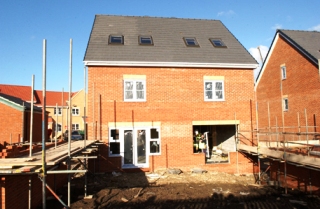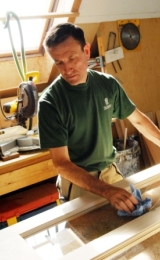Iain McIlwee, BWF Chief Executive
The opening to 2013 feels very much reminiscent of same time last year with “uncertainty” again the watch word – realistically more of the same is likely when we consider the economic environment in which we are working. We must, however, be encouraged that the economy is forecast to grow, but mindful that the forecast is for a modest rate of 1.1%.
 Within the customer markets, private sector house building is set to return to growth, which should be a shot in the arm for many of our members (for 60% this is their key market). The housing shortage is gathering increased political interest and a turnaround in 2013 could pave the way for double digit growth in 2014 and 2015. We are also encouraged by recent reports that timber windows are regaining market share against competitive materials. The domestic refurb market is always more difficult to call, it is about confidence and we saw this dissolve throughout 2012 – within our own membership those anticipating “declines in the next 12 months” doubled between our Q1 and Q3 surveys. The other key issue for refurb is the Green Deal, the stuttering start it seems unlikely that bullish DECC figures will become reality, but we would be wrong to dismiss it altogether. In the broader market, PF2 may provide some renewed investment and the education market should be boosted by finance announced for free schools and academies, but commercial and public sector markets are not likely to change.
Within the customer markets, private sector house building is set to return to growth, which should be a shot in the arm for many of our members (for 60% this is their key market). The housing shortage is gathering increased political interest and a turnaround in 2013 could pave the way for double digit growth in 2014 and 2015. We are also encouraged by recent reports that timber windows are regaining market share against competitive materials. The domestic refurb market is always more difficult to call, it is about confidence and we saw this dissolve throughout 2012 – within our own membership those anticipating “declines in the next 12 months” doubled between our Q1 and Q3 surveys. The other key issue for refurb is the Green Deal, the stuttering start it seems unlikely that bullish DECC figures will become reality, but we would be wrong to dismiss it altogether. In the broader market, PF2 may provide some renewed investment and the education market should be boosted by finance announced for free schools and academies, but commercial and public sector markets are not likely to change.
As BWF we will continue to call for Treasury to give us a clearer picture of growth strategy and put their money behind the rhetoric of building our way out of recession. We still see a very scatter gun approach to construction and politically the landscape is perhaps more uncertain with the coalition in a higher state of fragility. We are in politically unprecedented times and as the electioneering for May 2015 starts we may well see the coalition progressively turning in on itself.
 Beyond the economic and political trends, there is a tidal wave of legislative and regulatory change set to hit the woodworking sector. The big three are EU Timber Regulation in March, Building Regulations in April and October and the Construction Products Regulation (complete with CE Marking requirements) coming into force in July. We were pleased to see the announcement just before Christmas on Consequential improvements not being mandated as this would undoubtedly have acted as a market inhibitor, however, whilst we now have guidance on how Part K will change in 2013 we still await with interest the Part L changes that could have serious ramifications for windows and doors manufacturers. CE Marking will remain a big subject within the industry as inevitably more of our products will have to embrace these requirements. It is vital companies focus not just the technical considerations, but ensuring their customers and specifiers are informed and not confused by change – this is a key focus for us at BWF, but we urge all companies to engage with their customers on these key changes.
Beyond the economic and political trends, there is a tidal wave of legislative and regulatory change set to hit the woodworking sector. The big three are EU Timber Regulation in March, Building Regulations in April and October and the Construction Products Regulation (complete with CE Marking requirements) coming into force in July. We were pleased to see the announcement just before Christmas on Consequential improvements not being mandated as this would undoubtedly have acted as a market inhibitor, however, whilst we now have guidance on how Part K will change in 2013 we still await with interest the Part L changes that could have serious ramifications for windows and doors manufacturers. CE Marking will remain a big subject within the industry as inevitably more of our products will have to embrace these requirements. It is vital companies focus not just the technical considerations, but ensuring their customers and specifiers are informed and not confused by change – this is a key focus for us at BWF, but we urge all companies to engage with their customers on these key changes.
One thing I can offer in the way of certainty is that BWF can help. Our specialist helpline dealt with over 2,000 phone calls this year, and with each enquiry we grow our knowledge. Interest in Fire Doors peaked in 2012 with traffic to our BWF CERTIFIRE site increasing by 1,000% over the period and with the BWF Stair Scheme growing to embrace an estimated 70% of UK manufacture, we are starting to see an impact here and new projects opening up for timber stairs. More than 80 joinery businesses became new members of the BWF in 2012, and with each member we get stronger. Together with other members of the Timber Industry Accord and with the Construction Products Association, we will continue to fight for better recognition of the benefits of timber and a healthier business environment for woodworking companies in the future.